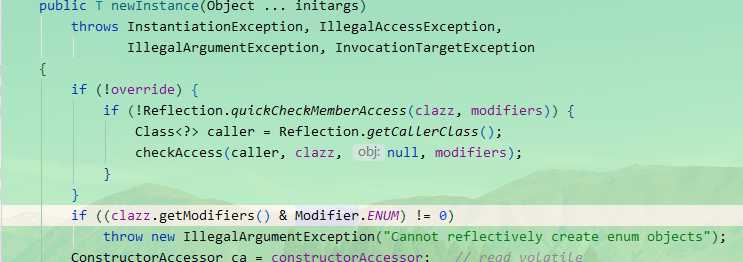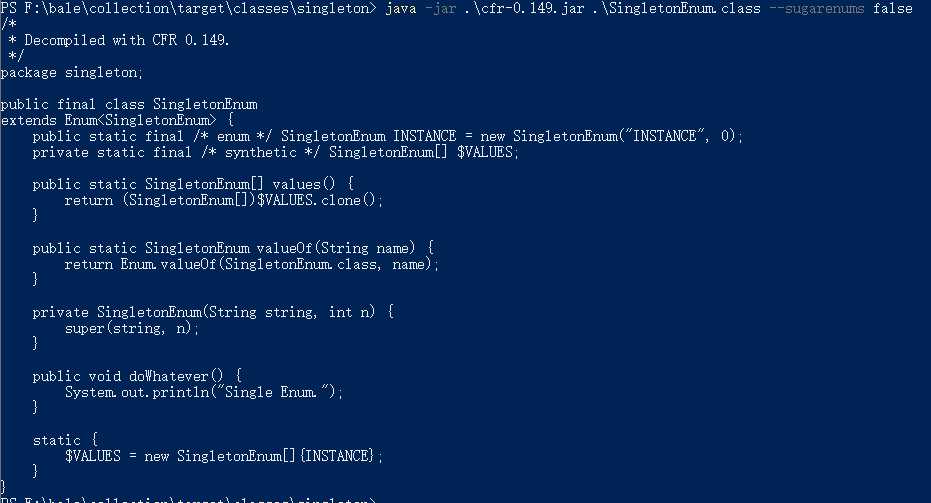Java设计模式001 --- 单例模式
2021-01-20 11:15
标签:设置 根据 win 方法 inf 破坏 let 类加载 odex 前言 什么是单例模式?就是在一个应用程序中,一个类的实例有且仅有一个;这个类负责创建该类的实例; 一般来说单例是有状态的对象,比如全局设置、数据库dao实例、全局资源等,并且可以根据需求延迟加载或者即时加载; 即时加载单例模式 1、静态域单例(我不习惯别人说的饿汉、懒汉) 使用方法:SingleTon1.getInstance() 特点:在类加载的时候就初始化好了,无线程安全问题; 即时加载,但是存在单例被破坏的风险,如使用反射、序列化 反射方式: 序列化方式(前提是单例类实现了Serializale): 2、上述问题的解决方案 为了解决反射对单例造成的破坏,可以做如下修改:在私有构造方法中判断实例是否为null,否则抛运行时异常 上述方法对序列化不起作用,这也从侧面验证了反序列化创建的对象不依赖类的构造器,而是由JVM创建的; 为了解决序列化对单例造成的破坏,可做如下修改:在序列化类中添加私有readResolve方法 虽然有以上方法可以解决上述问题,但是有更简便的单例模式 --- 枚举单例 3、枚举单例模式 枚举单例有如下几个有点:线程安全、能够防止反射和序列化带来的破坏、实现简单 使用方法:SingletonEnum.INSTANCE.doWhatever() 验证下反射和序列化场景是否会破坏单例: 运行结果: 为啥使用反射的时候会抛异常呢?这是因为反射的源码是这样写的: 那么又为啥枚举单例能够保证单例不被序列化破坏呢? 这是因为Java中规定,每个枚举变量在JVM中都是唯一的,并且Java还规定,枚举类在反序列化时使用枚举类的valueOf方法 枚举类反编译结果如下: 线程安全又是为什么?从反编译结果就能看出,INSTANCE是静态的,并且初始化时就创建了实例 未完待续。。。 Java设计模式001 --- 单例模式 标签:设置 根据 win 方法 inf 破坏 let 类加载 odex 原文地址:https://www.cnblogs.com/sniffs/p/12901754.htmlpublic class Singleton1 {
private static Singleton1 instance = new Singleton1();
// 是有构造器, 防止被实例化
private Singleton1() {
}
public static Singleton1 getInstance() {
return instance;
}
public void doWhatever() {
}
}
public static void main(String[] args) throws NoSuchMethodException, IllegalAccessException, InvocationTargetException, InstantiationException {
Class

public static void main(String[] args) {
Singleton1 singleton = Singleton1.getInstance();
File file = new File("src\\main\\resources\\singleton.txt");
try (FileOutputStream fos = new FileOutputStream(file);
ObjectOutputStream oos = new ObjectOutputStream(fos)) {
oos.writeObject(singleton);
} catch (IOException ex) {
ex.printStackTrace();
}
try (FileInputStream fis = new FileInputStream(file);
ObjectInputStream ois = new ObjectInputStream(fis)) {
Singleton1 singleton1 = (Singleton1) ois.readObject();
System.out.println(singleton == singleton1);
} catch (IOException | ClassNotFoundException e) {
e.printStackTrace();
}
}

// 是有构造器, 防止被实例化
private Singleton1() {
if (instance != null) {
throw new RuntimeException();
}
}

private Object readResolve() {
return instance;
}

public enum SingletonEnum {
INSTANCE;
public void doWhatever() {
System.out.println("Single Enum.");
}
}
public static void main(String[] args) throws NoSuchMethodException, IllegalAccessException, InvocationTargetException, InstantiationException {
SingletonEnum instance = SingletonEnum.INSTANCE;
// 验证两次获取的是否是同一个对象
System.out.println(instance == SingletonEnum.INSTANCE);
// 序列化场景
File file = new File("src\\main\\resources\\singleton.txt");
try (FileOutputStream fos = new FileOutputStream(file);
ObjectOutputStream oos = new ObjectOutputStream(fos)) {
oos.writeObject(instance);
} catch (IOException ex) {
ex.printStackTrace();
}
try (FileInputStream fis = new FileInputStream(file);
ObjectInputStream ois = new ObjectInputStream(fis)) {
SingletonEnum instance2 = (SingletonEnum) ois.readObject();
System.out.println(instance == instance2);
} catch (IOException | ClassNotFoundException e) {
e.printStackTrace();
}
// 反射场景
Class



下一篇:SPFA算法以及负环判断【模板】